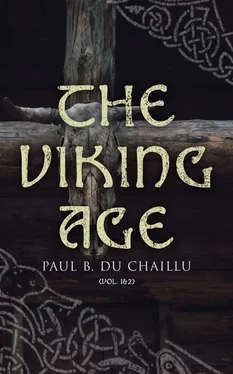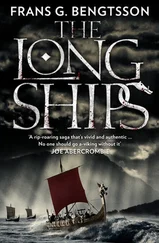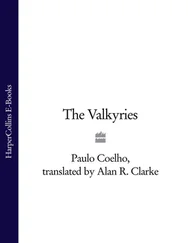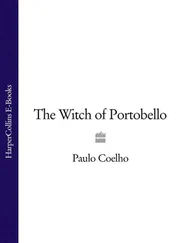The writers of the English and Frankish chronicles were the worst enemies of the Northmen, ignorant and bigoted men when judged by the standard of our time; through their writings we hardly know anything of the customs of their own people. They could see nothing good in a man who had not a religion identical with their own.
Still allowance must be made for the chroniclers; they wrote the history of their own period with the bigotry, passions, and hatreds, of their times.
The striking fact brought vividly before our mind is that the people of the North, even before the time when they carried their warfare into Gaul and Britain, possessed a degree of civilisation which would be difficult for us to realise were it not that the antiquities help us in a most remarkable manner, and in many essential points, to corroborate the truthfulness of the Eddas and Sagas.
The indisputable fact remains that both the Gauls and the Britons were conquered by the Romans and afterwards by the Northern tribes.
This Northern civilisation was peculiar to itself, having nothing in common with the Roman world. Rome knew nothing of these people till they began to frequent the coasts of her North Sea provinces, in the days of Tacitus, and after his time the Mediterranean. The North was separated from Rome by the swamps and forests of Germania—a vague term given to a country north and north-east of Italy, a land without boundaries, and inhabited by a great number of warlike, wild, uncivilised tribes. According to the accounts of Roman writers, these people were very unlike those of the North, and we must take the description given of them to be correct, as there is no archæological discovery to prove the contrary. They were distinct; one was comparatively civilised, the other was not.
The manly civilisation the Northmen possessed was their own; from their records, corroborated by finds in Southern Russia, it seems to have advanced north from about the shores of the Black Sea, and we shall be able to see in the perusal of these pages how many Northern customs were like those of the ancient Greeks.
A view of the past history of the world will show us that the growth of nations which have become powerful has been remarkably steady, and has depended upon the superior intelligence of the conquering people over their neighbours; just as to-day the nations who have taken possession of far-off lands and extended their domain, are superior to the conquered.
The museums of Copenhagen, Stockholm, Christiania, Bergen, Lünd, Göteborg, and many smaller ones in the provincial towns of the three Scandinavian kingdoms, show a most wonderful collection of antiquities which stand unrivalled in Central and Northern Europe for their wealth of weapons and costly objects of gold and silver, belonging to the bronze and iron age, and every year additions are made.
The weapons found with their peculiar northern ornamentation, and the superb ring coats-of-mail, show the skill of the people in working iron. A great number of their early swords and other weapons are damascened even so far back as the beginning of the Christian era, and show either that this art was practised in the North long before its introduction into the rest of Europe from Damascus by the Crusaders, or that the Norsemen were so far advanced as to be able to appreciate the artistic manufactures of Southern nations.
The remnants of articles of clothing with graceful patterns, interwoven with threads of gold and silver, which have fortunately escaped entire destruction, show the existence of great skill in weaving. Entire suits of wearing apparel remain to tell us how some of the people dressed in the beginning of our era.
Beautiful vessels of silver and gold also testify to the taste and luxury of those early times. The knowledge of the art of writing and of gilding is clearly demonstrated. In some cases, nearly twenty centuries have not been able to tarnish or obliterate the splendour of the gilt jewels of the Northmen. We find among their remains—either of their own manufacture or imported, perhaps as spoils of war— repoussé work of gold or silver, bronze, silver, and wood work covered with the thinnest sheets of gold; the filigree work displays great skill, and some of it could not be surpassed now. Many objects are ornamented with niello , and of so thorough a northern pattern, that they are incontestably of home manufacture. The art of enamelling seems also to have been known to the artificers of the period.
Objects, many of which show much refined taste, such as superb specimens of glass vessels with exquisite painted subjects—unrivalled for their beauty of pattern, even in the museums of Italy and Russia—objects of bronze, &c., make us pause with astonishment, and musingly ask ourselves from what country these came. The names of Etruria, of ancient Greece, and of Rome, naturally occur to our minds.
Other objects of unquestionable Roman and Greek manufacture, and hundreds and thousands of coins, of the first, second, third and fourth centuries of the Christian era, show the early intercourse the people of the North had with the western and eastern Roman empire, and with Frisia, Gaul, and Britain.
A careful perusal of the Eddas and Sagas will enable us, with the help of the ancient Greek and Latin writers, and without any serious break in the chain of events, to make out a fairly continuous history which throws considerable light on the progenitors of the English-speaking people, their migrations northward from their old home on the shores of the Black Sea, their religion, and the settlement of Scandinavia, of England, and other countries.
CHAPTER II.
ROMAN AND GREEK ACCOUNTS OF THE NORTHMEN.
Table of Contents
The three maritime tribes of the North—The fleets of the Sueones—Expeditions of Saxons and Franks—Home of these tribes—The tribes of Germania not seafaring—Probable origin of the names Saxons and Franks.
Roman writers give us the names of three maritime tribes of the North, which were called by them Sueones , Saxones , and Franci . The first of these, which is the earliest mentioned, is thus described by Tacitus (circ. 57–117 A.D.):—
“Hence the States of the Sueones, situated in the ocean itself, are not only powerful on land, but also have mighty fleets. The shape of their ships is different, in that, having a prow at each end, they are always ready for running on to the beach. They are not worked by sails, nor are the oars fastened to the sides in regular order, but left loose as in some rivers, so that they can be shifted here or there as circumstances may require.” 4
The word Sviar , which is constantly met with in the Sagas to denote the inhabitants of Svithjod (Sweden), or the country of which Upsala was the capital, corresponds somewhat to the name Sueones, and it is highly probable that in Sueones we have the root of Sviar and of Svithjod . The ships described by Tacitus are exactly like those which are described in this work as having been found in the North.
It stands to reason that the maritime power of the Sueones must have been the growth of centuries before the time of Tacitus, and from analogy of historical records we know that the fleets of powerful nations do not remain idle. Hence we must come to the conclusion that the Sueones navigated the sea long before the time of Tacitus, an hypothesis which is implied by the Eddas and Sagas as well as by the antiquities discovered.
That the Sueones, with such fleets, did not navigate westward further than Frisia is not credible, the more so that it was only necessary for them to follow the coast in order to come to the shores of Gaul, from which they could see Britain, and such maritime people must have had intercourse with the inhabitants of that island at that period; indeed, the objects of the earlier iron age discovered in Britain, which were until lately classed as Anglo-Roman, are identical with those of the country from which these people came, i.e., Scandinavia.
Читать дальше












